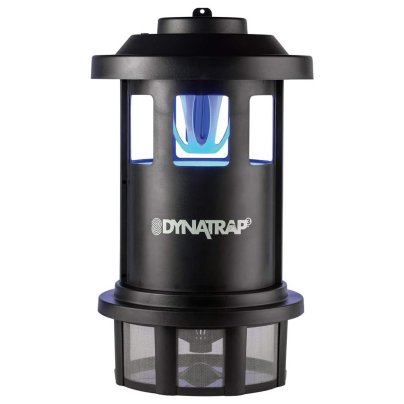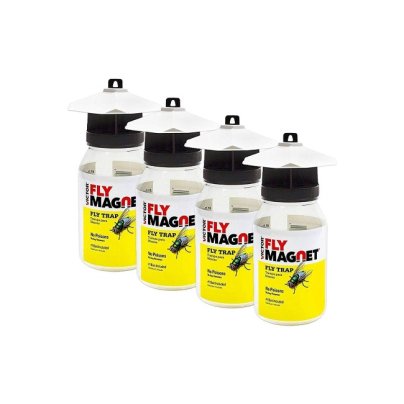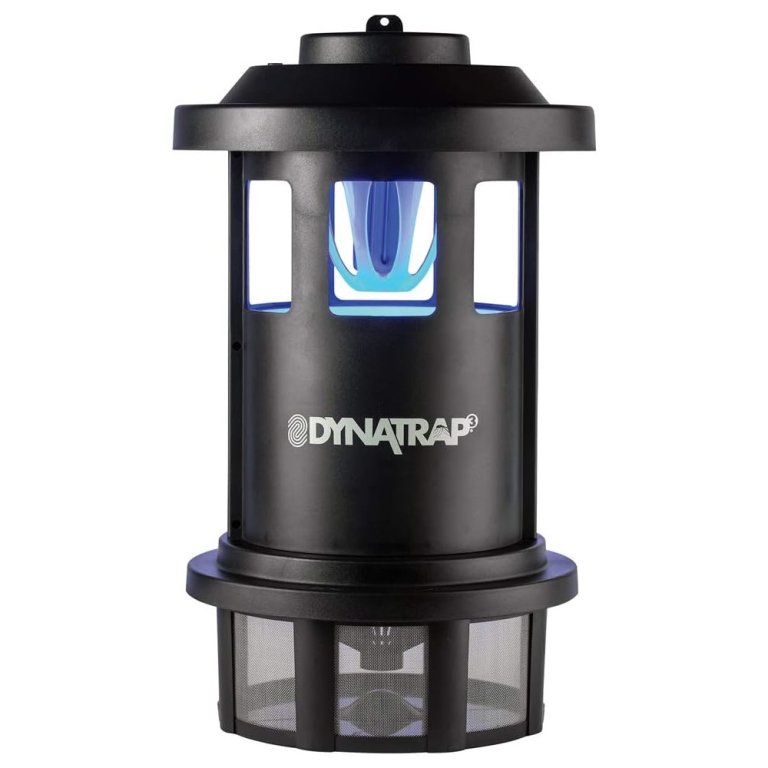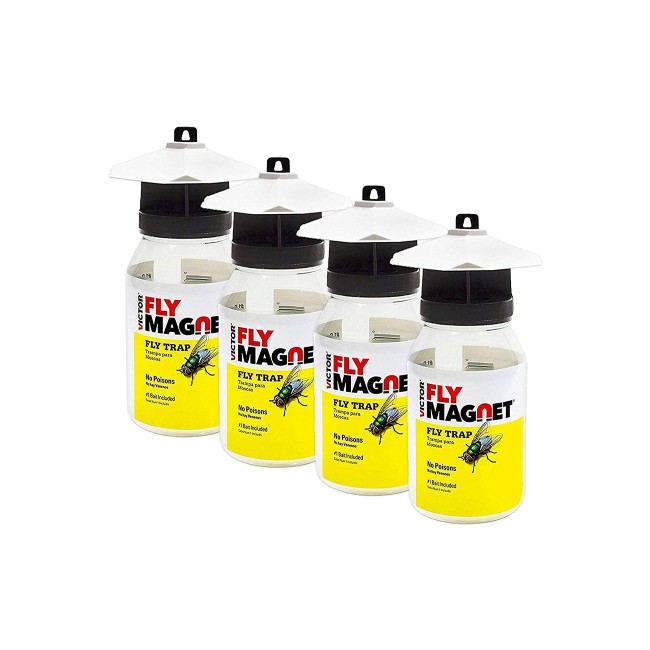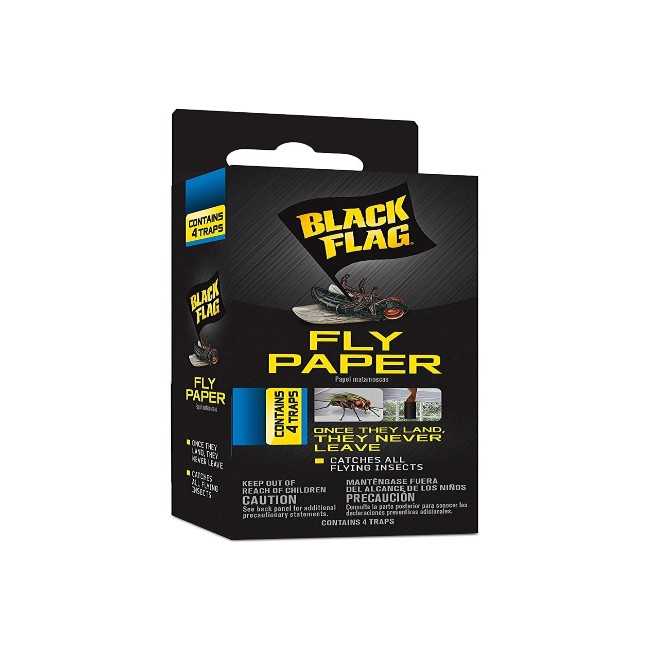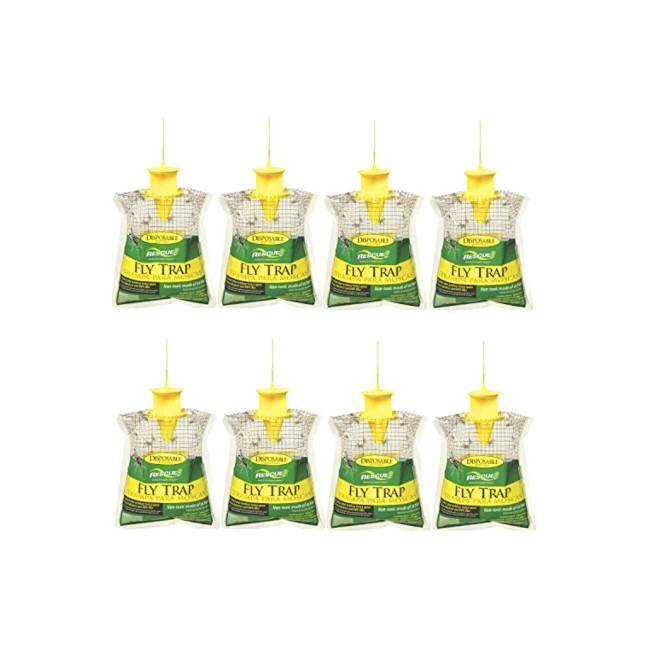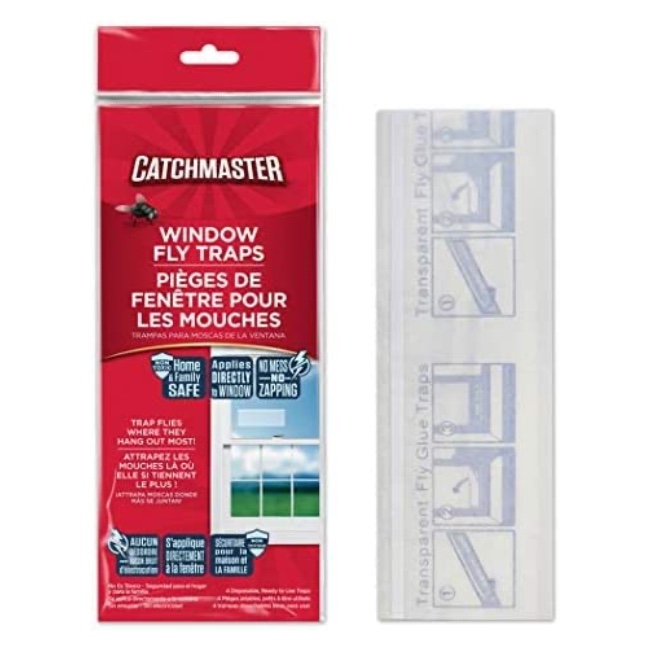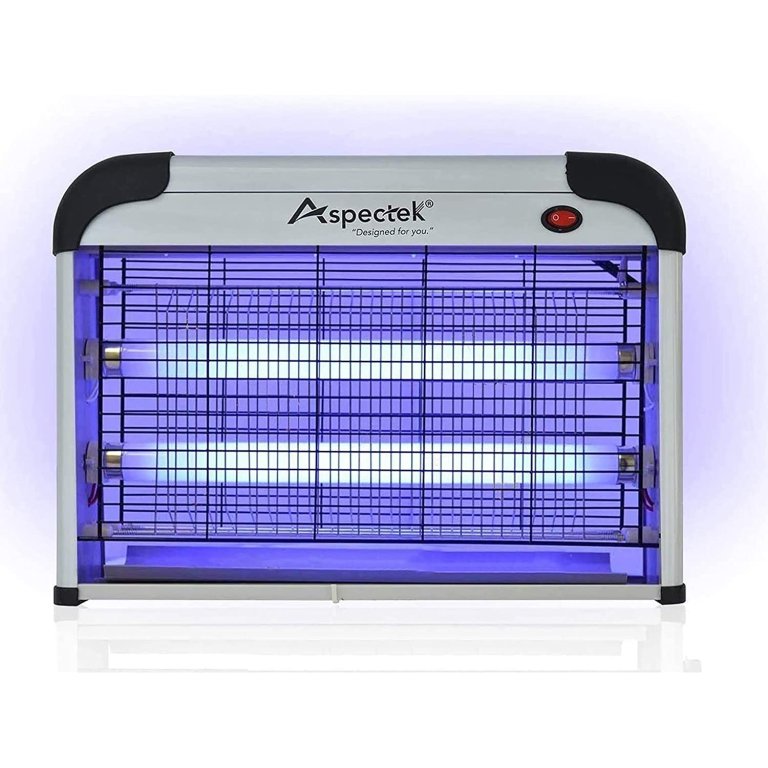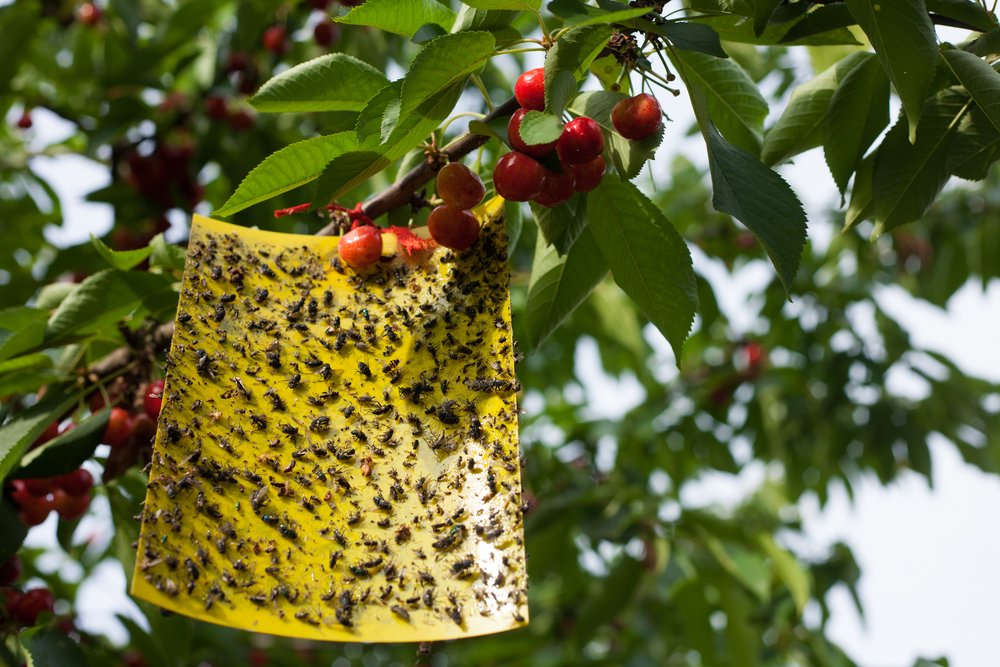
We may earn revenue from the products available on this page and participate in affiliate programs. Learn More ›
Controlling flies may seem like an impossible battle since they reproduce quickly and are so challenging to eliminate. That’s why we thoroughly researched the top options to find the best fly traps to catch those buggers with little effort on your end.
Peter Rania, president and CEO of Waltham Pest Control in Burlington, Massachusetts, shares that “as an exterminator with over 40 years of experience, I’ve found fly traps to be an effective way to reduce unwanted fly populations in residential and commercial settings.” You can install, hang, or plug in fly traps wherever you need them and forget about them while they do their job. Instead of playing bug buster and knocking knickknacks off the shelf with errant swats of a fly swatter, you can enjoy grilling or playing Frisbee.
We recommend the DynaTrap ¾ Acre Fly Trap With AtraktaGlo Light as our top pick for its great performance, affordability, and versatility. The following traps use sticky pads, electronic zappers, and old-fashioned funnels to trap and remove house flies from the equation. Let’s take a look at our choices for the best fly traps for DIY pest control.
- BEST OVERALL: DynaTrap ¾-Acre Fly Trap With AtraktaGlo Light
↓ Jump to Review - RUNNER-UP: Victor Fly Magnet Fly Trap
↓ Jump to Review - BEST BANG FOR THE BUCK: Black Flag Fly Paper
↓ Jump to Review - BEST DISPOSABLE: Rescue! Outdoor Disposable Hanging Fly Trap
↓ Jump to Review - BEST BUG ZAPPER: Black+Decker Bug Zapper
↓ Jump to Review - BEST FOR FRUIT FLIES: Katchy Indoor Insect Trap
↓ Jump to Review - BEST FOR INDOORS: Catchmaster Window Fly Trap
↓ Jump to Review - ALSO CONSIDER: Aspectek 20W Electric Bug Zapper
↓ Jump to Review
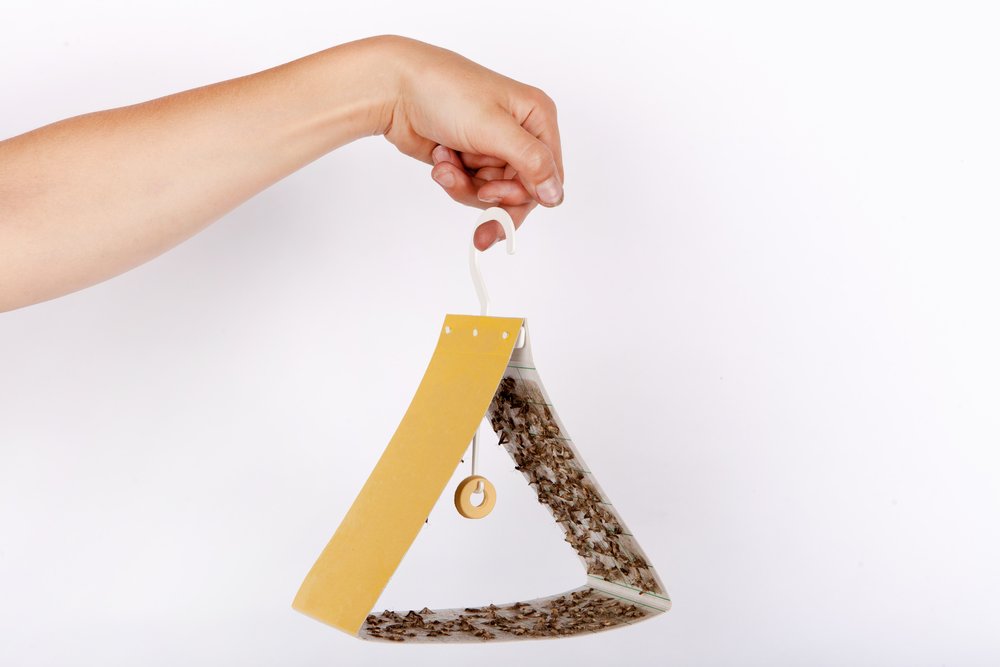
Before Buying a Fly Trap
The type of trap you choose matters. Some traps don’t last long or fill up too quickly to be useful in locations with a heavy concentration of flies, such as near a cattle ranch or horse corral.
Those particularly squeamish about dead bugs may want to choose their trap carefully. Most of these options require emptying the trap, which means handling a trap filled with dead insects.
Our Top Picks
DIY pest control can get the job done, but it can be hard to stomach. However, some of the best fly catcher choices consider the less appealing elements of this chore in their design. Here are our choices for the best fly traps for DIY pest control.
Best Overall
DynaTrap ¾-Acre Fly Trap With AtraktaGlo Light
What We Like
- Easy assembly of bug-catch basin
- Weather-resistant construction
- Covers up to ¾ acre
- Quiet operation with a powerful fan
What We Don’t Like
- Does not kill captured insects immediately
Product Specs
- Type: Electric
- Reusability: Yes
- Disposal: Manual emptying of catch basin
The DynaTrap ¾-acre electric fly trap is a comprehensive solution for tackling flying pests like mosquitoes, flies, and moths. By using a combination of ultraviolet (UV) light, heat, carbon dioxide, and a powerful vacuum fan, this fly and mosquito trap effectively attracts and captures insects over a large area. Its weather-resistant design allows it to be used as both an indoor and outdoor trap, making it versatile for various settings.
While it doesn’t kill insects instantly, handling the trap carefully when emptying it can prevent escapes. The DynaTrap’s easy assembly and extensive coverage make it a top choice for fly control, offering effective and reliable insect capture in a variety of environments.
Read our full review: DynaTrap ¾-Acre Fly Trap With AtraktaGlo Light
Get the DynaTrap fly trap at Amazon.
Runner-Up
Victor Fly Magnet Fly Trap
What We Like
- Potent bait and white lid to lure pests
- Contains nontoxic ingredients
- Simple reusable option
What We Don’t Like
- Best for outdoor use
Product Specs
- Type: Bait
- Reusability: Yes
- Disposal: Empty contents of jar
Victor’s Fly Magnet trap features a bottle style that uses bait and a specially designed entrance to trap and kill flies. The extremely potent bait and the lid’s white color attract flies, and although the bait lures them in, they’re unable to get out. They eventually drown in the very liquid that lured them into the trap. To reuse the trap, just dump the contents of the jar and replace the bait with a new packet of lure from Victor. This product is nonpoisonous and safe to use around children and pets.
Get the Victor fly trap at Amazon or Walmart.
Best Bang For The Buck
Black Flag Fly Paper
What We Like
- Comes with 4 trap strips
- Affordable, economical choice
- Quick and easy to set up
- Doesn’t include potentially harmful chemicals
What We Don’t Like
- Dead flies are visible until trap is removed
Product Specs
- Type: Sticky paper
- Reusability: Single use
- Disposal: Throw away once filled
Black Flag’s traps resemble the insect strips often used in horse and cattle barns. Simply open the package, let the paper unravel, and hang the trap in a spot that sees the most flies. The bugs are attracted to the surface and stick once they land, but the sticky traps don’t rely on harmful chemicals.
However, the paper traps don’t hide the bugs they’ve trapped—the flies just sit on the surface and die. Squeamish users may want to hang the strips up high, where flies gather in the warmth but out of the direct line of sight.
Get the Black Flag fly trap at Amazon (2-pack), Lowe’s, or Tractor Supply Co.
Best Disposable
Rescue! Outdoor Disposable Hanging Fly Trap
What We Like
- Easy, touch-free disposal
- Simple to use and set up
- Multipack can cover large areas
What We Don’t Like
- Can be messier than advertised
Product Specs
- Type: Bait
- Reusability: Single use
- Disposal: Throw away bag once filled
The Rescue! brand hanging fly trap uses a chemical compound that activates when the user fills the bag with water. The chemical attracts flies into the bag and poisons them. When the bag is full, simply remove the trap from its perch and throw it in the garbage. It’s a simple, effective, and mess-free method of fly control.
Though the Rescue! trap’s disposable nature makes it mess-free, it is so effective that users may have to replace it more often than some fly traps. Users can purchase an eight-pack of the traps for season-long use in most areas.
Get the Rescue! fly trap at Amazon (8-pack), Ace Hardware, Tractor Supply Co., or The Home Depot.
Best Bug Zapper
Black+Decker Bug Zapper
What We Like
- Easy to empty and clean
- UV light provides wide coverage indoors and out
- Convenient hanging hook included
What We Don’t Like
- Requires electrical outlet to operate
Product Specs
- Type: Zapper
- Reusable: Yes
- Disposal: Empty removable tray
This Black+Decker outdoor bug zapper protects against flying pests across as much as a half acre with its high-intensity UV light. Made for the outdoors, the waterproof housing keeps the zapper lit and operating even during a storm. Quiet operation and casing that keeps UV light out of the eyes make this zapper discreet.
The Black+Decker zapper includes several other practical features. A removable collection tray and small cleaning brush make it easy to maintain. The zapper also features a sleek and attractive cover, a hook for hanging, a flat base for tabletop use, and a 5-foot power cord.
Get the Black+Decker fly trap at Amazon.
Best Fruit Fly Trap
Katchy Indoor Insect Trap
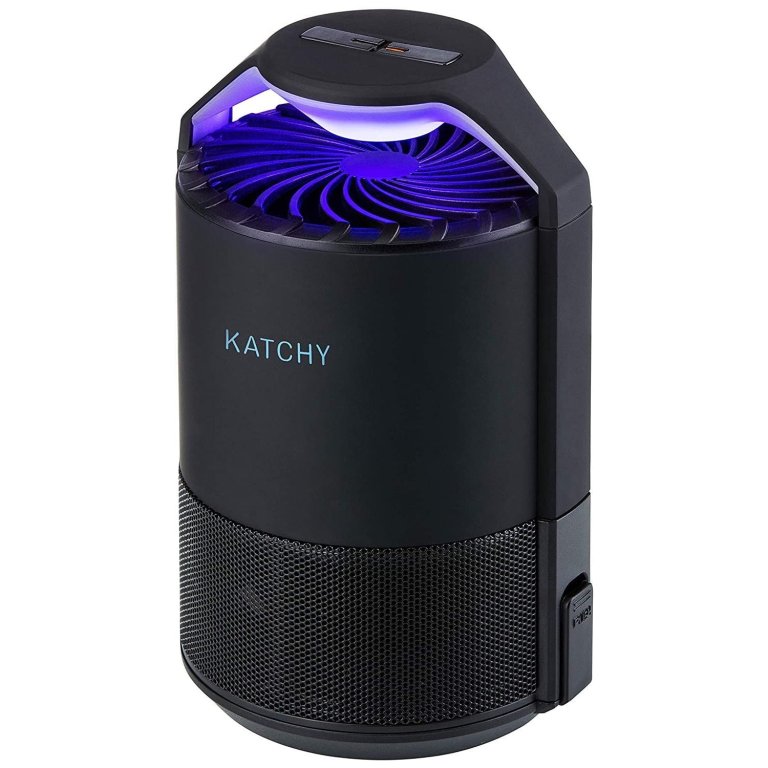 ON SALE NOW
ON SALE NOW
What We Like
- Works effectively overnight when bugs are most prevalent
- Very effective on fruit flies, mosquitoes, and gnats
- Quiet fan while operational
What We Don’t Like
- Not suitable for outdoors
Product Specs
- Type: UV light, fan, and adhesive
- Reusability: Yes
- Disposal: Empty container when full
Folks looking to set up fruit fly traps on their counter, on a bedside table, or even in a garage may want to check out Katchy’s indoor insect trap. First, the UV light attracts mosquitoes to the Katchy. Then, a fan sucks them in and traps them below. Finally, they land on a sticky pad where they dehydrate and die. And this model does it all while being quiet. Although this trap is designed for indoor use only, it takes a triple-threat approach to mosquito control and can be placed on a flat surface.
Users will want to change the sticky pads whenever they fill with dead mosquitoes to maintain the model’s effectiveness. Luckily, the kit comes with some replacements. The Katchy indoor insect trap is effective against mosquitoes, no-see-ums, gnats, and fruit flies, helping to keep flying pests under control. However, it can potentially catch pollinators as well, but this model works most effectively at night when bees and wasps are typically in their hives and nests.
Get the Katchy fly trap at Amazon or Walmart.
Best For Indoors
Catchmaster Window Fly Trap
What We Like
- Very easy to use
- Transparent so blends right in
- Waterproof, nontoxic, and disposable
What We Don’t Like
- Creates more waste than some comparable options
Product Specs
- Type: Glue
- Reusability: Single use
- Disposal: Throw out when full
Keeping mosquitoes, flies, and other flying insects out of the house can prevent irritation as well as bug bites. To keep flying pests out, rely on the window fly traps by Catchmaster. These handy and transparent glue traps can be attached to any window, windowsill, or garage door in your home to attract pests before they enter.
These sticky traps are waterproof, disposable, nontoxic, and last for up to a year. They are also easy to install: Simply remove the small release liner, place the trap where desired, and then remove the large release liner.
Get the Catchmaster fly trap at Amazon.
Also Consider
Aspectek 20W Electric Bug Zapper
What We Like
- Lasts for years with little maintenance
- Can be used indoors or outdoors
- Can lay flat or hang from included chain
What We Don’t Like
- Lethal option will not appeal to all
Product Specs
- Type: Zapper
- Reusability: Yes
- Disposal: Removable tray
For those who want a set-and-forget method of dealing with flying insects, the Aspectek 20W electric indoor bug zapper is just the ticket. This electric model can be used indoors or outdoors with the help of its zapper mesh screen. This screen not only eliminates bugs but also prevents the user, children, or pets from reaching the high-voltage electrical grid.
The light from this unit attracts insects in any room, and it can be hung, if necessary, with the included chain. Finally, the removable plastic tray at the bottom slides out to dispose of dead insects and debris, and the electric grid is self-cleaning.
Get the Aspectek bug zapper at Amazon.
Or, DIY Your Own Fly Traps
You may already know how to get rid of crane flies with a little DIY ingenuity, but you can make your own outdoor or indoor fly traps as well. It’s a thrifty, natural, and low-waste alternative to store-bought options that is cost-effective and allows you to use materials you likely already have at home. To create your DIY fly trap, you’ll need a plastic bottle, scissors, tape, apple cider vinegar, sugar, and liquid dish soap. Start by cutting off the top of the bottle and discarding the cap. Insert the top part upside down into the base to create a funnel. Add the apple cider vinegar and sugar (overripe fruit also works well here) into the bottom of the bottle. Fill the bottle base with water and a few drops of dish soap to improve your homemade fly trap’s efficiency.
Jump to Our Top Picks
How We Chose the Best Fly Traps
The best fly traps do just that: attract and then trap or kill house flies so they cannot escape and breed. In our testing, we looked at the effectiveness of the trapping design or mechanism. We also considered safety, especially when the trap uses chemicals. Ease of use is important as well, including setup, refilling, reusing, and cleaning.
We also considered disposal methods since emptying or throwing out the trap can be an unpopular task. Electronic traps require some setup, but they usually contain removable trays for easy emptying. Disposable traps, like this simple Black Flag fly trap, take the least amount of time to switch out.

What to Consider When Buying a Fly Trap
The range of different fly trap products on the market can be overwhelming, especially when you just want to get flies out of your house ASAP. Some products seem more like a gimmick than an actual solution, while others provide an effective method for maintaining a no-fly zone. Here are some characteristics of the best fly traps.
Types of Fly Traps
Calling an exterminator for most crawling bugs is a good move, but for flies, it’s probably money down the drain. The best way to end the flies’ reign of terror is to trap and eliminate them for good.
These products have special designs that lure flies into their grips and never let them go. Some might zap the bugs, while others trap them until they dehydrate. Poison is a popular choice. The needs of the household and the installation location of a fly trap (indoors or out) help determine the required style.
Outdoor Fly Traps
Outdoor fly traps possess the features necessary for outdoor locations. Outdoor fly traps are excellent for backyards, patio areas, barbecue grill stations, and even a garage or shop setting. Outdoor fly traps typically hold lots of dead bugs, and some are reusable.
The difference between a trap designed for outdoor use and one designed for indoor use typically comes down to the design. Most outdoor fly traps contain chemicals or liquids that would make a mess if they leaked or were dropped inside the home.
These chemicals attract the flies through scent, killing them once they’ve eaten the liquid or exhausted themselves trying to exit the trap.
Odorless Indoor Fly Traps
Some indoor fly trap options can help control the winged bug population without the unattractive odors or chemicals emitted by outdoor-style models.
Many tabletop indoor fly traps include a bug-attracting light that lures the flies, a fan to push them into the base, and a sticky surface that grabs hold and doesn’t let go. To reuse this type of trap, simply replace the sticky strip and place the trap again.
Another effective fly trap option that works particularly well with fruit flies contains bait (juice, a sugar cube, or something relatively pleasant and chemical-free) to lure the flies into a funnel. Once in the trap, they can’t find their way out; thus, the tunnel becomes their final resting place. The trap can get a little nasty over a few days, and users must pour out the juice and replace it, typically while it’s full of floating bug bodies.
UV Bug-Zapping Machines
UV bug zappers are the way to go when waging serious warfare against these pesky pests. The light attracts the flying insects (flies, mosquitoes, fruit flies, and moths), and once they land on the light, the zapper electrifies and kills them.
These fly trap models are particularly useful at night when the light is most noticeable, although they can also help control flies during the day. They’re most commonly used outdoors, but you can also purchase an indoor model (if you don’t mind the sound of a bug frying).
UV traps don’t require sticky pads, scented lures, or anything messier than occasionally emptying the tray of dead bugs. Set up a zapper in a raised position slightly away from the patio or deck, plug it in, and let it work.
Trapping Design/Mechanism
It’s important to understand the method that a trap uses to catch flies. For buyers who like to keep things simple, a sticky pad or strip grabs hold of the flies’ bodies so they can’t escape.
The funnel-style trap mentioned earlier creates a puzzle that flies can’t figure out how to exit and can be used along with a sticky surface or a chemical poison. They land on the funnel and walk in, but they can’t get back out.
Other more technologically advanced methods include zappers and fans that dehydrate the bugs. These are effective, but they require a power source.
Safety
Considering the fly trap’s safety features is important, especially when used around children or pets. Hang chemical traps high enough that a child, pet, or even livestock can’t get to them. “For those concerned about harsh chemicals,” says Rania, “natural traps utilizing vinegar, sugar, and dish soap are excellent eco-friendly options that effectively attract and drown common flies.”
For safety, plug outdoor zappers and traps into a ground-fault circuit interrupter (GFCI) outlet. If the outlet gets wet, the GFCI will trip when it detects a surge, shutting down the outlet and the attached device.
Ease of Use
The simpler the fly trap, the more likely it is to succeed. Dealing with complicated traps and chemical concoctions might discourage their use.
Electronic models that hang on a nail or screw or sit on a tabletop start trapping bugs in no time at all. Some even forgo an on/off switch. They need only a power source, and they set about their job automatically.
If using another fly trap method, look into how to set it up. Traps that require a lot of fiddling with trap doors, chemicals, and complicated hanging methods can frustrate users even if the traps work well.
Disposal/Maintenance
One of the least desirable features of a fly trap is that the trap must be emptied a few times a year, the sticky strip replaced, or a wet bag full of dead flies thrown out. Look for products that are easy to empty. On electronic models, having a removable tray makes discarding the waste a simpler process.
For a straightforward solution, consider purchasing single-use traps that can be thrown away.
The Advantages of Using the Best Fly Traps
Since there are so many options, fly traps can hang, plug into outlets, or activate virtually anywhere. And we all know sitting outside is more enjoyable when not constantly swatting bugs. But houseflies are more than just annoying; research has shown that they can transmit germs and bacteria, which can lead to food poisoning, dysentery, and diarrhea.
For those with active children or pets, it’s hard to keep bugs out of the house. When doors are opened frequently, bugs inevitably make their way inside. An indoor fly catcher can help offset this swinging-door inconvenience by quietly plucking insects from the air and collecting them on a sticky pad.
FAQs
Electric zappers can catch and jolt flies quickly, but the sound might be jarring. Still, they are fast, use no chemicals, and emit no odors.
Some fly traps with odorous chemicals can attract flies from the neighborhood, but they will catch and trap most of them. Still, placement matters. Place the trap where you and the flies can reach it but where it won’t bring their buddies to your pool party.
That depends on whether you can stop the breeding process. House flies on average live for less than a month, and one female house fly can lay batches of 75 to 120 eggs five or six times in her lifetime. Fruit flies live a little longer and can be even more prolific.
The best fly traps work instantly. However, chemical- or food-based baits might take a day or so to reach their full scent and begin attracting lots of flies. Strips and electric zappers should start to work immediately.
Some air fresheners may help repel flies, but it won’t kill them. In the past, formaldehyde in air fresheners was suggested as a pest solution, but the chemical is no longer used in today’s air fresheners.
If indoors, choose a mostly sunny spot, like a window. Flies also flock to warmth, so higher spots will catch more flies and prevent family members from having to duck the traps. Placing them high outdoors also helps, typically from a roof or other overhang, as long as it’s not too close to your living space. Or just observe where flies tend to gather around your yard, such as outdoor garbage bins, and place the paper traps near those spots.
